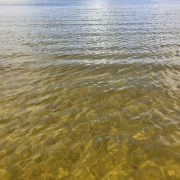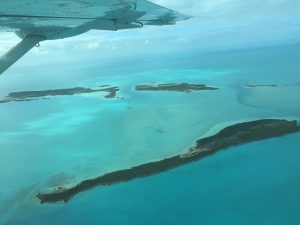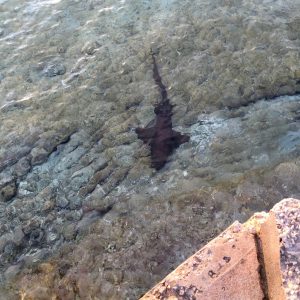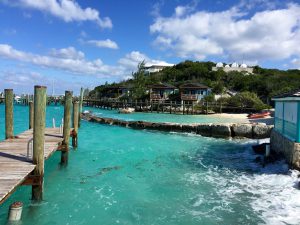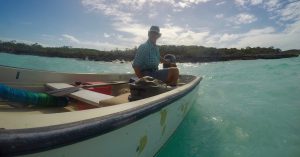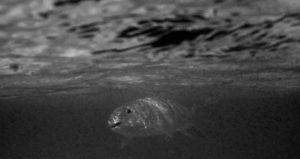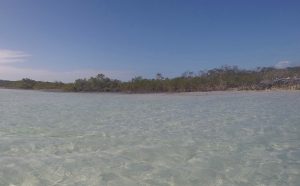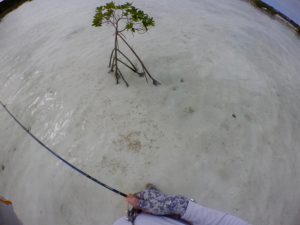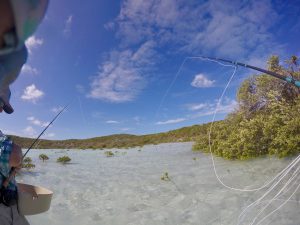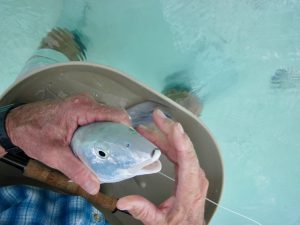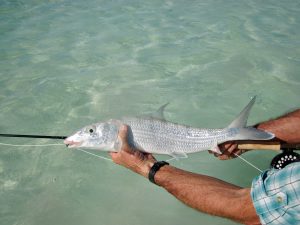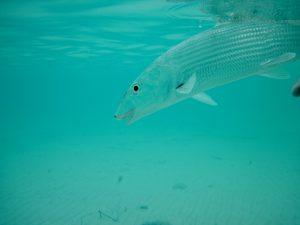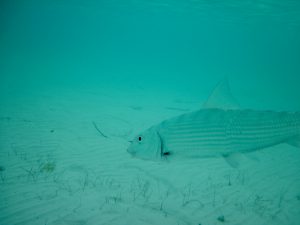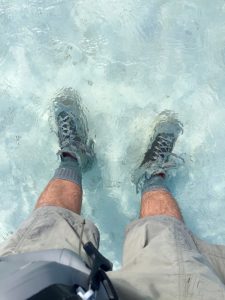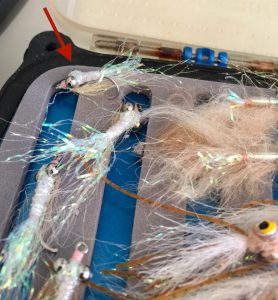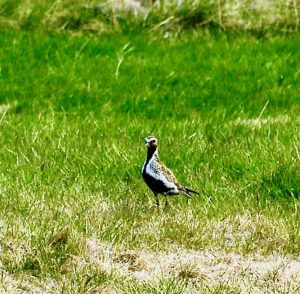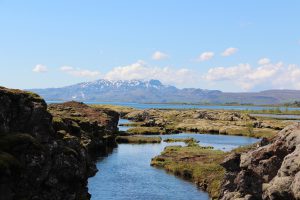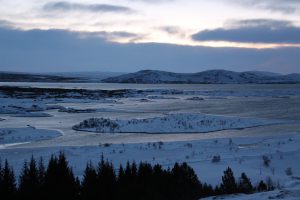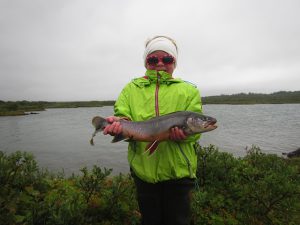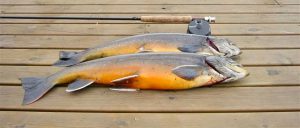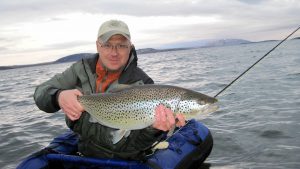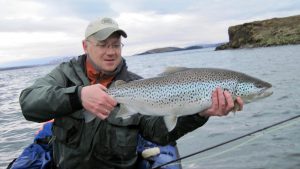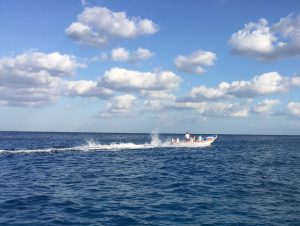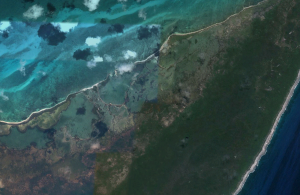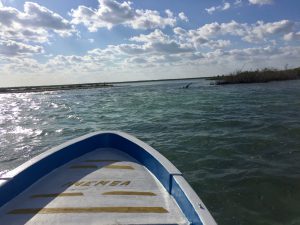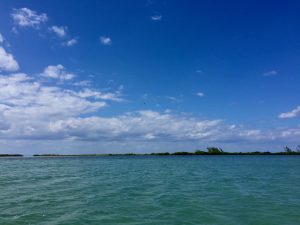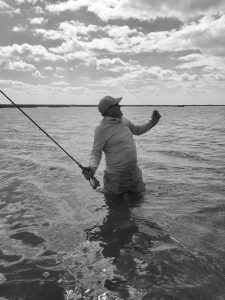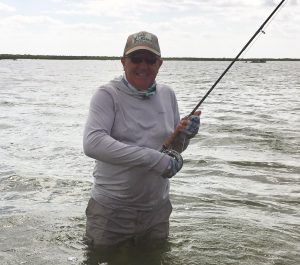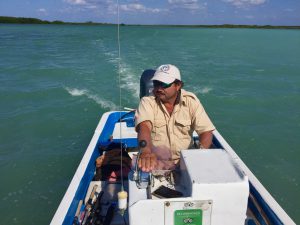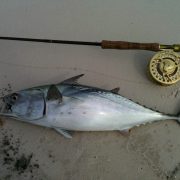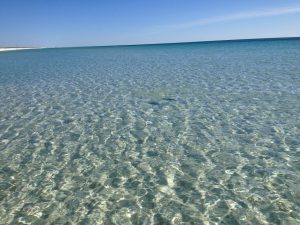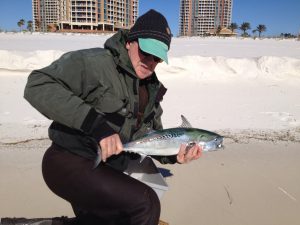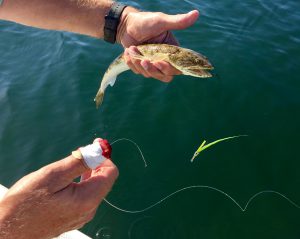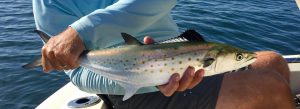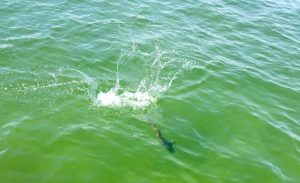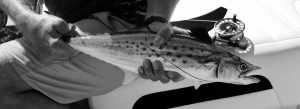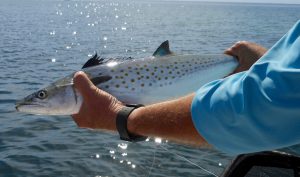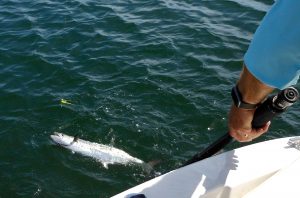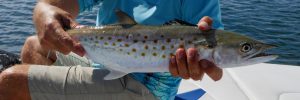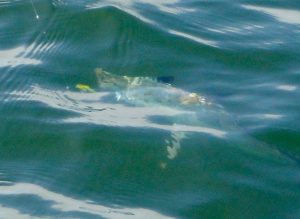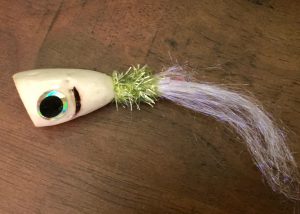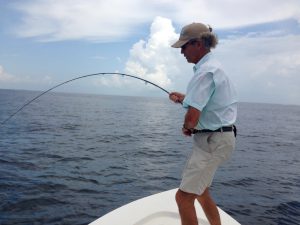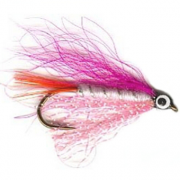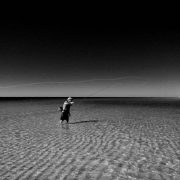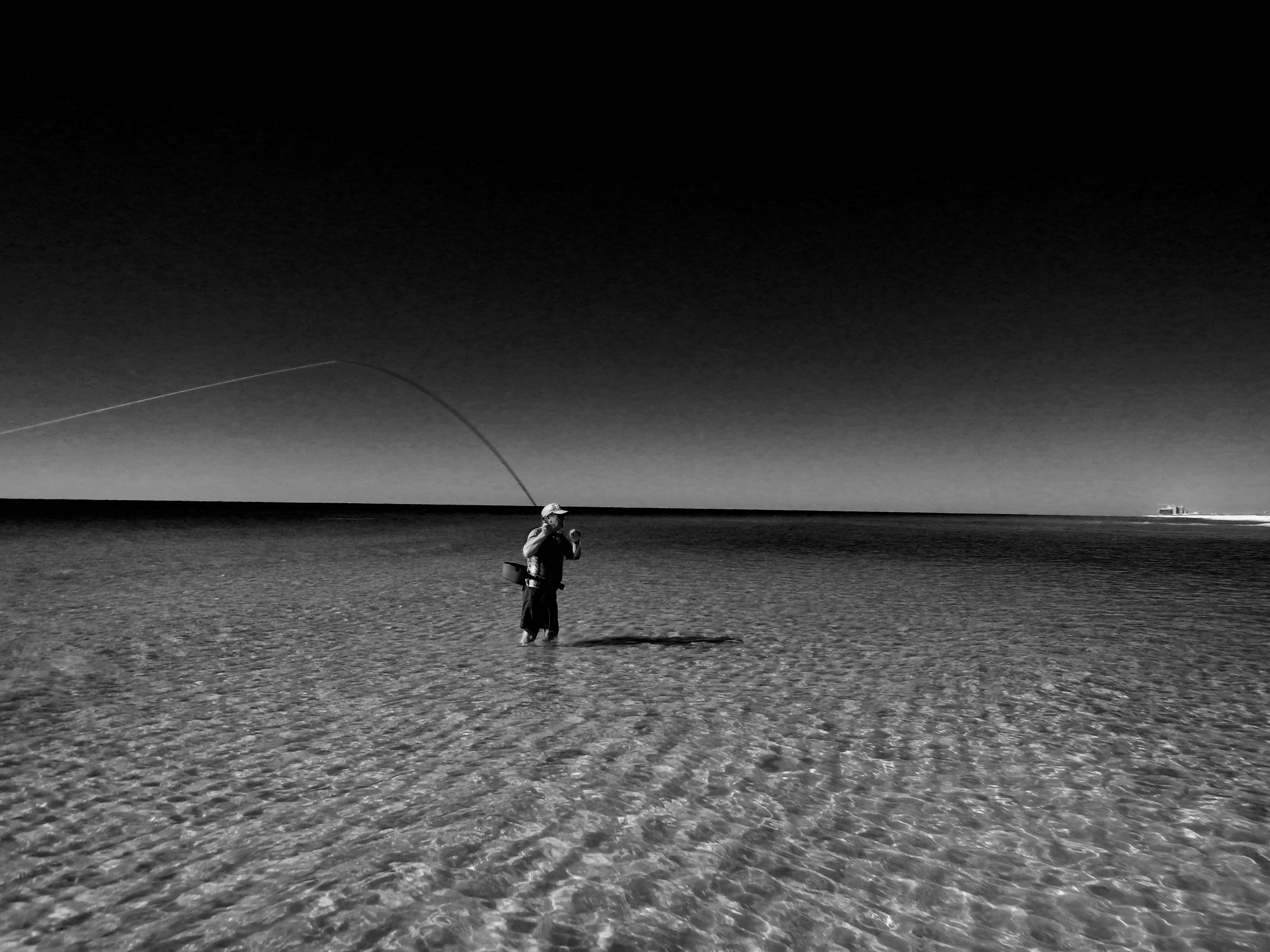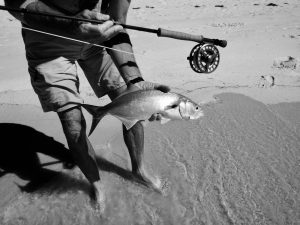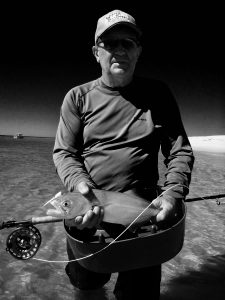The feature image gives you a good idea how difficult it is to spot the fish. The water is a bit tea colored from the prior heavy rains. In the upper left quadrant there is a fish fighting, but you can see the swirl in the water on close inspection.
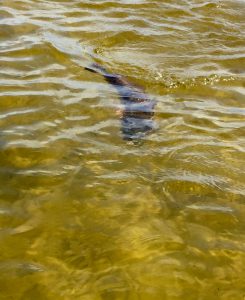
Redfish being brought in
Redfish are found in the extensive bay systems connecting to the Gulf of Mexico, and also the Gulf side. In the eighties they were over harvested and catch limitations were put in place. The stock has rebounded, and restrictions on their catch are still in place. Today the limit in the Panhandle of Florida is one fish in the slot range. Slot range fish? I took me a while to figure this one out – it means the fish has to be longer than 18 inches and no more than 27 inches long. This is a somewhat curious/unusual rule, but the big Redfish are actually the most valuable spawners of this species, according to research. At any rate we can all agree that dead fish will not spawn. In local parlance the under the slot fish are called rat reds. I find that a poor choice of words for such beloved and sought after game fish. Then we have the slot fish, which you can harvest (but should not). Why do we need to harvest a slot red (they do not come close to the fighting abilities of the big fish) when everybody wants to catch the big ones? Then over the slot size we call them Reds, and still larger Bull Reds, which is a bit of a misnomer as the females are bigger than the males. They start spawning in the fall and that’s when we see them in huge schools come to the surface in the bays. This phenomenon is called “Running of the Bulls,” but is the “Run of the Cows” really.

The Running of the Bulls armada
Now there will be lots of boats in the bay, and total bedlam when a school is spotted. All the boaters gun their engines, and all the boats will converge at the same spot, putting the fish down. Fly fishing during this mayhem is not enjoyable at all, and I call this type “Olympic style fishing.” The big mommas can release 60 million eggs per spawn! The guys have sure their work cut out for them. Imagine that! Redfish grow fast, and at one year are eight inches long, and three-year fish are 29 inches, and reach 39-44 inches 11-35 years old. So these fish can get quite old. They prefer temperature from 50-80F.
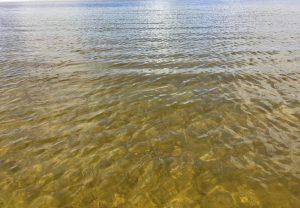
The view over the flat
In January the temperatures drop and now some skill is required to find and catch them. We do not blind cast for them so we must visually locate the fish. Now the crowds are gone, and God is in his Heaven, and we love this time of year. We work on the theory that when it is very cold the fish will move deeper into the channels, and when the weather improves and the sun shines the fish will move on to the shallows and flats and use the sun to warm themselves. But which flats? I have an idea but I am not going to tell. The infrared rays of the sun heat fastest the shallow water, and fish can found close to shore or further out. It is good to have a theory like that and it strengthens our prejudices when positive things happen but it is only a theory until we gain better understanding.
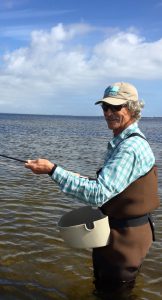
Baz bringing in the Redfish
So our sets of requirements are reasonably clear. In very choppy water the surface is so broken up that it becomes hard to spot them – so reasonably calm waters. We also need sunshine. The fish can sometimes be spotted on the bare sand close to a spot of sea grass, just parked right to a grass bed. It is exceptional to spot them when on the grass beds. We hike in looking as nerdy as possible in our waders and stripping baskets. We’d only been in the water about ten minutes when we start seeing fish. The trick is moving very slowly to let our eyes adjust to the “background” of grass beds and varying depths of sandy-bottom.
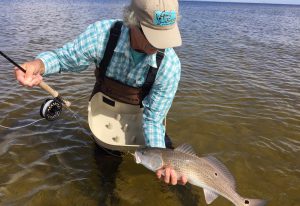
Baz with Redfish
When they are on the move that is the best way of seeing them. The back of these fish is darker than the sand, and it is about the only concession they allow us. I am starting to spot fish under Captain Baz’s tutelage. “Baz I spotted that one?” “Good – it is the size of a submarine.” I tend to walk into those.
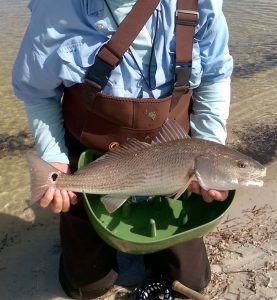
Redfish prior to release
On the flats we fish the reds do not tail at all. When I fished shallow water in Texas I frequently saw tailing reds. Tailing means that they are rooting on the bottom, vertical in the water column, with their tails above the surface. Those are feeding fish and take our offerings if we can get them there. Why they do not tail on “our” flats probably has to do with the hard packed quartz sand we frequent. Their snouts would in all likelihood become damaged.

Redfish being brought in
The moving fish require you to take notice of their speed and direction, and you try to place the fly where your calculations tell you that the fish is going to be and intercept their line of travel. If shallow say two feet then I do not like overly weighted flies. They are boring to cast and land with too much of a splash to my liking. However they need to sink. So try to land the fly softly and have your leader twelve feet long. If you have problems turning over your leader shorten it. When you come tight to a fish strip set the hook. Trout fly fishermen are taught to raise their rod tip to strike a fish and many reds are lost cause of that. DO NOT. When the line comes taut keep the rod pointed at the fish and give a good pull or two with the line hand called strip strike, then you may bring the rod tip up. Remember it is more important to keep the line taut than get it onto the reel. So strip strike and keep line taut. If the fish comes to you do not even try to get him onto the reel. Just pull in line and keep it taut. If he runs away let out line and transfer onto the reel. The reds are heavy and that is how they fight but no spectacular runs await and they do not jump.
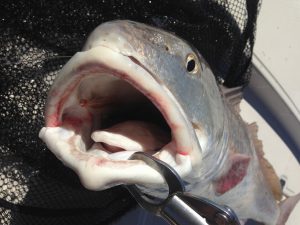
Redfish with fly inside mouth – not one in story – fly much deeper
One of the fish caught had the small fly deep in his throat, and we had a hard time getting at it. It got so difficult that we had to put it in the water to freshen its oxygen supplies. What carried the day was a release clamp where you place the leader in the cylinder of the clamp and keep the leader taut then advance the instrument towards the fly where it will hit the bend of the hook and now you push the hook back and voila out it comes. Of course we fish with barbless hooks.
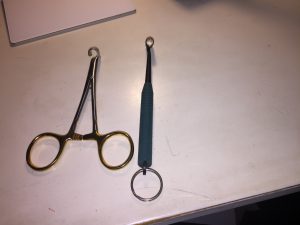
Slick clamp release and Ketchum release
Now our fish was a bit dazed and I hold it by the tail and drag it backwards. Works well in rivers when reviving fish, as you drag the fish against the current. The gill plates (operculum) usually open and water gets to the gills. In the still water this did not unfold, so I grab the edge of the gill plate and open the gill slit, and now I can pump water over the gills by moving the gill plate back and forth. Lo and behold the red recovers and you keep doing this until he starts to try to get away then it is time for “au revoir.” Back home when reviving big Seatrout I tailed them and stroked their bellies continuously and then let go of the tail. Curiously these fish were in no hurry to depart seemed to like being stroked and then just slowly they edge away (there probably is some deep pathology at work in the dark recesses of my mind). I like to think that they have forgiven me my intrusion into their lives (entitled to my alternate fact eh?). It is a special feeling to have these big fish on your hand like that.
Our calculations have been borne out, and our oversized brains have outsmarted a creature with no college degree, and we feel good about ourselves. Understandably we are very happy and the fishing goddess has smiled on us. Back to the car and now I discover that the right leg of the waders is badly leaking with water spilling over to the left side. Her highness has a warped sense of humor.
http://www.buddys-coins.com/fishpage/Redfish.htm
http://myfwc.com/fishing/saltwater/recreational/red-drum/
https://en.wikipedia.org/wiki/Red_drum
- Redfish with fly inside mouth
- The Running of the Bulls armada
- Slick clamp release and Ketchum release
- The fly used
- Baz with Redfish
- Redfish being brought in
- Redfish being brought in
- The view over the flat
- Baz bringing in the Redfish

